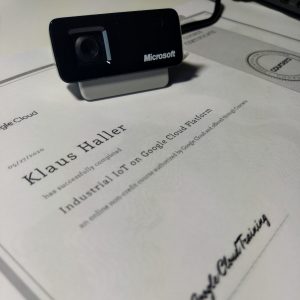Klaus Haller, 28.5.2020

Yesterday, I completed my “Industrial IoT on Google Cloud Platform“ course. It requires around 2-3 full days of work, mostly hands-on. I took the course for two reasons: to understand the technology that drives IoT and to get hands-on experience with the Google Cloud. Up to now, I only worked a bit with Azure last year and quite a lot with Amazon’s AWS Cloud this year.
In the early 2000s, sensor networks were big in research. You deploy sensors to the outdoors, and they have to find a way to communicate in a peer-to-peer way and to agree on actions or come to conclusions this way. And isn’t IoT something like the good old world of sensor networks? Things look differently in 2020. There are no peer-to-peer sensor networks. There are a few global cloud providers that (want to) manage all deployed sensors of our world. And, to be honest, they have compelling solutions.
A typical IoT architecture has three elements:
- Sensors: You deploy them to measure the physical world, e.g., heat sensors, CCTVs, voice sensors.
- Devices: They connect sensors and the cloud using the HTTP or the MQTT (Message Queuing Telemetry Transport) protocol.
- Once the data is in the cloud, you process the data like any other data using the typical data/stream/event processing, data management, and data visualization technologies. These are, in case of Google, Cloud Pub/Sub, Big Query, Google Dataprep, or Google Data Studio.
The advantages of using a cloud solution are their possibility to scale, their global presence, and the platform as a service offering with many features to build solutions quickly. Interestingly, Google starts offering features to decentralize the processing by moving computing to the “edge”, i.e., closer to the actual devices.
So, what is my conclusion after completing the course? First, the user experience when working with the Google UI is a little bit different than if you work with AWS. That is normal. Second, and most important, it became clear to me how easy it is to add IoT devices to a cloud solution, at least, if you abstract from the challenges of getting devices and sensors set up and configured correctly. And if you wonder what I try to have a look at in the next days and weeks? IT security, IT security, and maybe security for Amazon’s AWS cloud ?